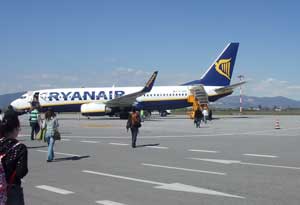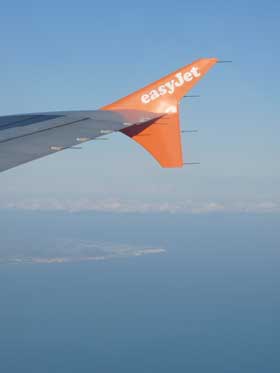Budget destinations for cheap flights to Italy
Several budget airlines fly from the UK to Italian destinations, and it’s easy to find a cheap flight to Italy. On this page we list the budget airports served by UK flights, but note that airlines do sometimes change their routes and the frequency of flights. Check for the latest information on their own websites.
Many of the budget destinations need no introduction. The appeal of Rome, Venice, and Milan is obvious. But the cheapest flights to Italy may deposit you in lesser-known tourist destinations. Some of these make good bases for exploring further, many merit a weekend break in themselves. As well as listing the budget airline destinations from the UK and Ireland, we also provide a guide to the airports and suggest nearby holiday destinations – this should prove particularly useful if you are booking a bargain flight to Italy first, and planning your holiday afterwards.
Find and book hotels. With location maps and guest reviews.
Ryanair flights to Italy

Ryanair fly from London Stansted to Rome Ciampino, Pisa, Genoa, Ancona, Milan (actually Bergamo Airport), Venice Treviso, Brescia, Turin, Bologna (Forli), Trieste, Pescara, Perugia, Parma, Bari, Brindisi, Lamezia, Palermo in Sicily and Alghero (in Sardinia).
From Bournemouth Ryanair fly to Pisa and Milan Bergamo.
From Bristol they fly to Turin and Milan Bergamo.
From London Luton they fly to Rome Ciampino and Milan Bergamo.
From East Midlands there are flights to Rimini, Rome Ciampino, Pisa, Alghero, Milan Bergamo.
From Liverpool you can fly Ryanair to Rome Ciampino, Pisa, Alghero, Milan Bergamo and Venice Treviso.
From Newcastle there are flights to Milan Bergamo.
From Glasgow Prestwick in Scotland you can travel to Rome Ciampino, Pisa and Milan Bergamo.
From Ireland
From Dublin Ryanair fly to Trapani in Sicily, Alghero, Rome Ciampino, Pisa, Bologna, Turin, Venice Treviso and Milan Bergamo.
From Shannon there are flights to Venice Treviso and Milan Bergamo.
Easyjet flights to Italy

Easyjet will fly you from London Stansted to Naples.
From Gatwick Easyjet fly to Palermo, Rome Ciampino, Pisa, Venice Marco Polo, Olbia in Sardinia, Milan Linate and Milan Malpensa.
From London Luton they fly to Rimini, Cagliari in Sardinia, and Turin.
From Bristol Airport Easyjet have flights to Rome Ciampino, Pisa, Venice Marco Polo, Milan Malpensa.
From East Midlands Airport they fly to Rome Ciampino and Venice Marco Polo.
From Newcastle there are flights to Rome.
From Edinburgh there are flights to Milan Malpensa.
From Northern Ireland
From Belfast you can travel to Venice Marco Polo.
Other airlines
British Airways fly to most of the main Italian destinations; they’re more expensive than the budget airlines but they do sometimes have decent special offers.
These and other European airlines also operate budget flights between Italy and other European airports, and there are also low-cost internal flights within Italy.
When you’re planning your holiday, it’s worth bearing in mind that nearby airports outside Italy also make possible flight destinations – for example, several budget airlines fly to Nice in France, which is close to the Italian border and gives access to the Liguria region and the Italian Riviera.
> Notes on budget airlines, and more advice about travel to Italy on our ‘Get there’ page
> Guide to Italian airports, public transport connections and suggestions for holiday destinations in the surrounding area
Advice for flying (especially for those using a budget airline)
Here are our tips for managing your journey efficiently. Some of the points are specific to budget airlines, others apply whatever route you’re flying. In these days of long queues and tight security, you should do your bit to avoid delays to your journey and those of other travellers.
Most important
1. Read all the information, rules and baggage instructions provided with your booking and on your airline’s website. Check for banned items, liquids, the number of items allowed along with weight and size restrictions. With Ryanair you cannot pool your luggage allowances, so don’t take one heavy suitcase for two people; stick to a small case each. There are always delays at check-in caused by travellers who haven’t paid attention to baggage requirements: unpacking their cases on the floor and starting pointless arguments with airport staff.
2. Be prepared with your baggage, ID and boarding card. Your baggage and liquids bag should be ready before you join the security queues, and you will need your documents on several occasions so keep them at the ready, and remember that every member of your party should hold their own. That’s another common delay: “My husband has my boarding card”.
3. Wear practical clothing thinking of both airport checks and safety women in knee-high laced-up stiletto boots: no-one wants to wait behind you at the emergency exit. Avoid metal objects, jewellery and buckles that will set off metal detectors (and if you must wear them, remove them before the security scan). As with your hand-luggage, you won’t activate any of the alarms if you follow the advice given. On my last few flights I have been delayed by men who repeatedly set off the security scanner and are sent back, each time discovering yet another metal item, phone, keys, loose change in their pockets – after instructional information boards, videos and forty minutes in the queue to prepare themselves. And also by a woman who spent five minutes trying to pull off her knee-high boots when requested to do so (her boyfriend eventually managed to wrestle them off).
Step-by-step guide to air travel
1. Advance planning: some airlines allow you to check-in online. Ryanair will soon insist upon it. Check the rules availability of online check-in may depend on your departure airport and whether you have hold luggage. If your airline allows online check-in for passengers with hold baggage, you may still find queues at the bag drop. Travelling with only hand-luggage is much more convenient and cheaper with budget airlines – but you must ensure it meets all the size and weight requirements and doesn’t contain any banned items. You will also need to cart it around the airport and lift it into the crammed lockers onboard.
2. Check-in opens two hours before flights. The longest queues are usually at this time, but if you arrive later (especially at Stansted) you risk long queues for security. Your baggage should be in order. You’ll need your passport and your booking reference. This is where disorganised travellers cause huge delays attempting to re-pack suitcases or sneak un-booked buggies onboard.
3. The next step: security controls. Here it is very important you have luggage, liquids etc. only as permitted by the latest rules. Don’t wait until you reach the barrier or are told what to do. At the time of writing there are strict rules on carrying one item only (for most airlines), on banned objects, and on liquids being in small containers in special plastic bags. Yet, unbelievably, passengers still set off alarms by carrying scissors in their baggage, or huge arrays of bottles. Most airports are very stern about this and if you disregard the rules you will delay your own party and lots of other, more considerate travellers. Frequently there is only one queue per security gate and any delays you cause will hold up everyone so remove your coat, remove your liquids bag, take off metal objects, produce your laptop and sail through without accusing beeps or bag-searches. You will need your boarding card and sometimes your passport.
4. Passport control (when flying from Italy to the UK). Have your passport open on the photograph page and show your boarding card.
5. Boarding gates. Get here in plenty of time, and join the appropriate queue depending on whether or not you have paid for priority boarding. Again, you will need your passport (hold it open) and your boarding card. The staff will tear off the main part of your boarding card. Keep the stub in your hand as you need to show it as you get on the plane.
6. Getting on board: have your boarding card stub ready and keep it safe; if you have hold luggage the staff will have affixed a sticky label which is your luggage receipt: you’ll want this if your case goes missing. Use both entrances to the plane if possible. Choose a seat quickly budget airlines do not have seating numbers; you sit where you can. Stow your luggage and loose coats and keep the aisle clear. Budget airlines have very short turn-around times and are always in a hurry to take off.
7. Safety: it’s always important and you owe it to your fellow passengers to observe all the rules. No phones, no electronic devices during take-off (that includes personal stereos and hand-held games), no getting up while the seatbelt sign is illuminated. Don’t talk through the safety lectures even if they’re in a foreign language or you’ve heard them a hundred times.
8. Alighting: sitting near an exit makes this much quicker. Don’t get off the plane and stand around on the tarmac under the wing smoking cigarettes (we have actually seen Italians doing this at Stansted; they got a proper telling-off from disbelieving crew). Get into the terminal building as quickly as you can, passport at the ready. At the little airports used by budget airlines there are often only one or two desks open and queues build up fast. Stansted can be a nightmare, with very long queues. Note that these may move at different speeds – the end queues are sometimes served by two desks, while some desks are manned by staff who have ‘security’ chats with each passenger – so keep your eyes open and change lanes if necessary. In Italy, try to avoid queues with obvious non-Europeans in them; their passport checks are likely to take much longer.
9. It’s a good idea to have the next stage of your travel in Italy planned. You may have to queue for bus tickets or information so again, try to beat your fellow passengers.
> Guide to Italian airports and their transport connections
On this site
Useful external links